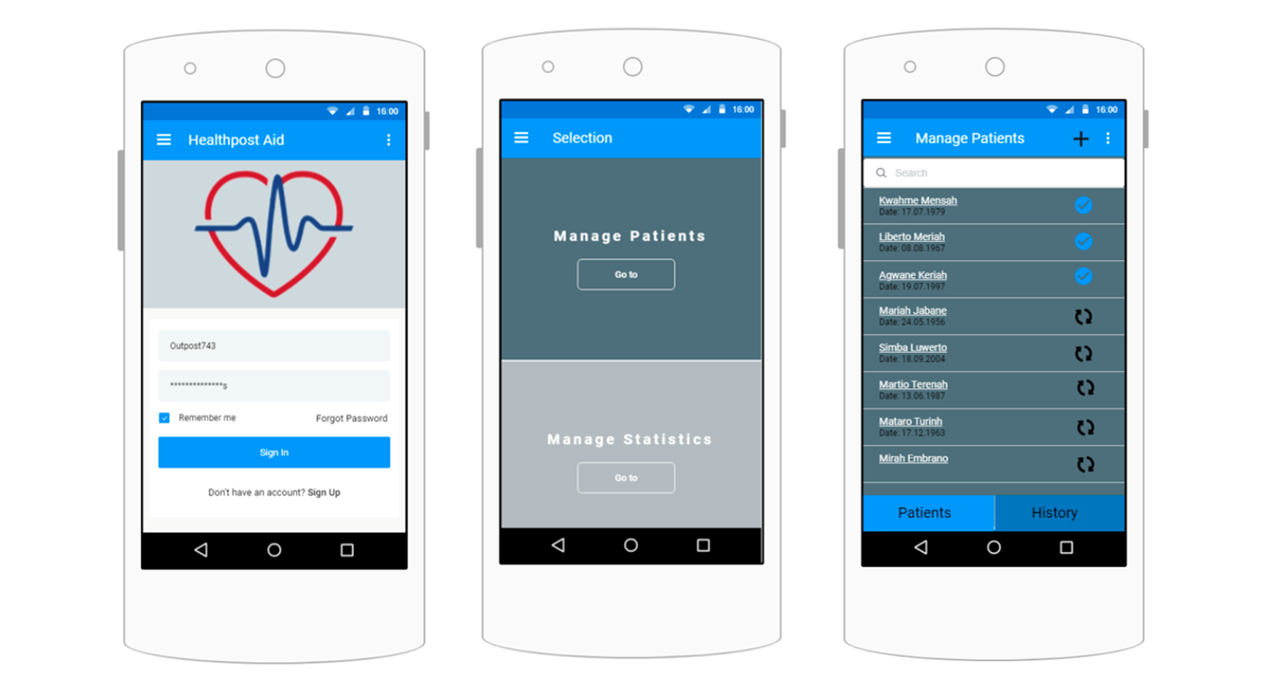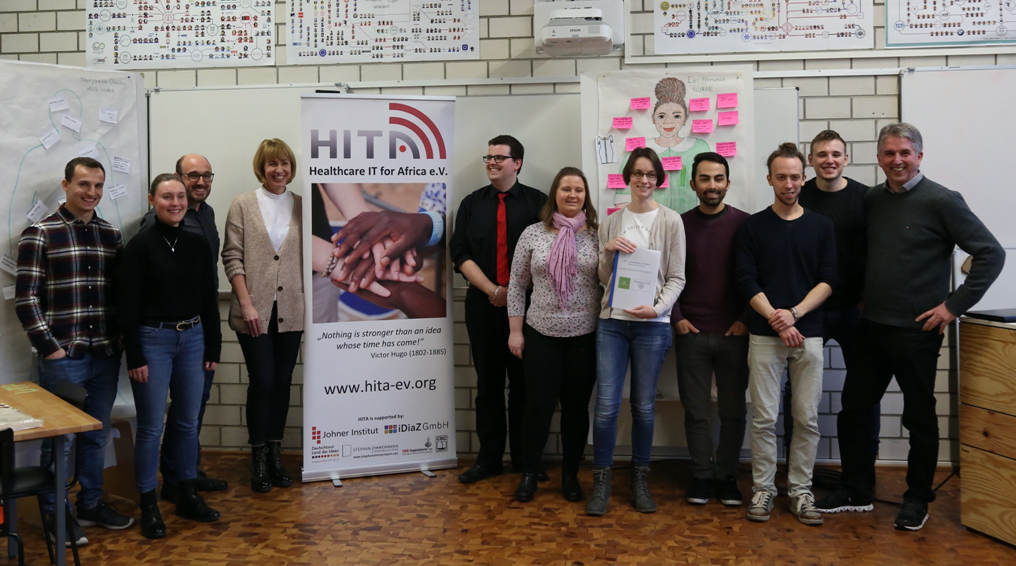Interview mit Professorin Kirstin Kohler – Hochschule Mannheim / inno.space
Co-Innovation von Studierenden der Hochschule Mannheim mit der Non-Profit-Organisation HITA e.V. im Kontext Digital Health – Eine Win-Win-Situation für die Beteiligten
Digitale Innovation wird häufig von technischen Fragestellungen getrieben. Dies spiegelt sich auch in den Curricula der entsprechenden Studiengänge wie Informatik oder Nachrichtentechnik. Doch die Entwicklungen der letzten Jahre haben deutlich gezeigt, dass Softwaresysteme große Auswirkungen auf gesellschaftliche Veränderungen haben können und ihre Gestaltung im soziokulturellen Kontext betrachtet werden muss, um deren nachhaltige Bedeutung abschätzen zu können. Man beachte bspw. die Wirkung von sozialen Medien oder die jüngsten Diskussionen zur Verwendung einer Corona App als prominente Vertreterin digitaler Innovationen. Hochschulen müssen sich also Lehrkonzepte überlegen, die die Studierenden für ihre soziale Verantwortung sensibilisieren und sie befähigen, Technikgestaltung von einer sozialen, gesellschaftlichen bzw. menschzentrierten Perspektive aus zu betreiben. Denn erfolgreiche digitale Innovation kann nur entstehen, wenn Nutzerzentriertheit und technischer Fortschritt im Einklang stehen und im kulturellen Kontext eingebunden sind.
Im Kurs User Centered Innovation haben 8 Studierende des Masterstudiengangs Software Engineering der Hochschule Mannheim in Zusammenarbeit mit HITA e.V. gezeigt, wie es gelingen kann, gemeinsam einen Mehrwert für eine gemeinnützige Institution zu schaffen und gleichzeitig die oben beschriebenen Kompetenzen im Rahmen eines Kurses zu entwickeln. HITA e.V. ist eine gemeinnützig tätige Nichtregierungsorganisation, deren Vision es ist, mithilfe von eHealth- und mHealth-Technologien zur Optimierung von Gesundheitssystemen in Afrika beizutragen. Während des projektbasierten Kurses haben die Studierenden über einen Zeitraum von 15 Wochen eine Lösung zu einer Herausforderung aus dem Alltag der HITA erarbeitet. Gleich zu Beginn des Projektes hat HITA die Studierenden mit folgender Frage konfrontiert: „Wie kann durch digitale Innovation das klinische Management und die Organisation einer lokalen Gemeindeklinik in Ghana unterstützt werden?“ Motiviert war diese Fragestellung durch die Erfahrungen der beiden HITA-Vertreter Thomas Erkert und Daniel Gerlach, die durch ihre ehrenamtliche Arbeit über umfassendes Hintergrundwissen zum ghanaischen Gesundheitssystem verfügen.
Die Hochschule verfolgt einen Ansatz der nutzerzentrierten Innovation, in dem Kreativmethoden, Prototyping und Nutzerinterviews angewendet werden, zum Beispiel nach der Design Thinking-Methodik. Dabei arbeiten die Studierenden mit sogenannten „Assignments“. Dies sind wöchentliche Aufgabenstellungen, mit denen die Studierenden schrittweise Methoden erlernen, um die komplexe Fragestellung zu bearbeiten, die an sie herangetragen wird. Die Fragestellung führt zunächst bei den Studierenden zu einer Unsicherheit, da sie wesentlich offener ist als die Fragestellungen anderer Kursformate. Die damit einhergehenden Freiheitsgrade des Lösungsraums sind ungewohnt und überfordern zunächst. Unter methodischer Anleitung der betreuenden Lehrkraft fand in den ersten Wochen die Exploration des Problemraums durch die Studierenden statt. Dazu gehörte es, Besonderheiten und Abläufe des ghanaischen Gesundheitssystems zu erkunden und die gesellschaftlichen Rahmenbedingungen des Landes zu verstehen. Dies hat den Studierenden die großen Unterschiede in Bezug auf Hygiene, Bettenkapazitäten, Behandlungsmethoden, Abläufe und Einrichtung der medizinischen Zentren im Vergleich zum eigenen Gesundheitssystem verdeutlicht. Basierend auf diesen Einsichten wurden verschiedene Personas erstellt, die die Erkenntnisse zur Zielgruppe und ihren täglichen Herausforderungen dokumentieren (in diesem Fall wurden Hebamme, Krankenschwester und Patient betrachtet). Das Beispiel der Krankenschwester ist in der Abbildung unten dargestellt.
Mit Blick auf die Zielgruppen waren die Studierenden dann gefordert, aufbauend auf ihrer umfassenden Kenntnis digitaler Technologie verschiedene Lösungen zu erdenken und diese grob zu skizzieren. Die Arbeit fand in Kleingruppen statt und hat zunächst zu mehr als 40 verschiedenen Ideen geführt. Aus diesen haben die Studierenden fünf Ideen zu sogenannten Low-Fidelity Prototypen weiterentwickelt. Dabei handelt es sich um Vorstufen des Produktes, die aus einfachen Materialen wie Papier und Pappe in kurzer Zeit erstellt werden. Die Ideen werden also zunächst nicht in Code umgesetzt, sondern in Konzeptrepräsentationen, die lediglich der Kommunikation und Diskussion dienen. Aus den sehr unterschiedlichen Konzeptideen wurden im Dialog mit den HITA-Vertretern die zwei vielversprechendsten ausgewählt. In den folgenden Wochen haben die Studierenden diese durch mehrere Iterationen zu clickbaren Demonstratoren auf dem Zielgerät ausgearbeitet. Es kamen wiederholte Methoden zum Einsatz, die die Güte der Ausarbeitung von verschiedenen Perspektiven aus beleuchteten (bspw. User Experience, Machbarkeit, Kosten).
Während des gesamten Kurses standen die HITA-Experten mit viel Einsatzbereitschaft im Dialog mit den Studierenden, um Fragen zu Ghana zu beantworten oder Rückmeldung zu den Konzeptideen zu geben. Die Studierenden konnten durch die intensive Beschäftigung mit dem ghanaischen Kontext erleben, wie eng der Einsatz einer Anwendung im konkreten Kontext mit deren Ausgestaltung und Implementierung verwoben ist. Das Highlight des Kurses war ein geführter Nutzertest mit dem ghanaischen Krankenhaus, in dem die Studierenden im Rahmen einer einstündigen Videokonferenz die Chance hatten, verschiedene Vertreter einer Klinik in Ghana durch ihre digitale Lösung zu führen, um deren Akzeptanz zu erkunden und Bedenken entgegenzunehmen. Dies war vor allem deshalb möglich, weil die HITA-Vertreter im Rahmen ihrer Reise nach Ghana die Videokonferenz vor Ort organisieren konnten. Zum Stolz aller Beteiligten waren die Rückmeldungen der potentiellen Nutzer überaus positiv und gaben ergänzende, wertvolle Impulse. Den offiziellen Abschluss des Projektes bildete schließlich eine umfassende Präsentation des Gesamtergebnisses durch die Studierenden vor Thomas Erkert und Daniel Gerlach von HITA e.V. auf dem Hochschul-Campus.
Die Kooperation mit der HITA e.V. war aus Sicht der betreuenden Professorin ein großer Gewinn für die Lehre. Sie hat den Studierenden ein Lernerlebnis ermöglicht, in dem sie die Folgen ihrer Technikentscheidungen in einem gesellschaftlichen Kontext reflektieren mussten. Auf diese Weise konnten die Studierenden sich ihrer Verantwortung, aber auch ihrer kreativen Möglichkeiten, bewusst werden. Gleichzeitig wurden sie für die Gegebenheiten einer anderen Kultur und Gesellschaft sensibilisiert, die von weit mehr Einschränkungen geprägt ist als die eigene Lebenswirklichkeit.
Der Kurs fand im inno.space (https://inno-space.de) statt, dem Kreativ- und Makerspace der Hochschule Mannheim, die Teil des weltweiten Design Factory Global Netzwerkes (https://dfgn.org) ist. Dort arbeiten Studierende nach dem Prinzip des Action-Based-Learnings in kreativer Lernumgebung ausschließlich an realen Fragestellungen. Im Gegensatz zur Kooperation mit HITA e.V. beschäftigen sich viele weitere inno.space-Projekte mit Herausforderungen von Firmen und sind damit stark von wirtschaftlichen Interessen geprägt. Durch die Zusammenarbeit mit einem Non-Profit-Unternehmen wie HITA e.V. gelingt es, die Nachhaltigkeit und das Allgemeinwohl stärker in den Fokus eines Kurses zu rücken. Eine Aufgabe, die die Hochschulen, als Einrichtungen mit gesellschaftlicher Verantwortung, zunehmend wahrnehmen. Alles in allem war das Projekt eine glückliche Win-Win-Situation, wie sie sich nur selten ergibt und aus Sicht der Hochschule Mannheim hoffentlich eine Wiederholung findet.
In einem aufschlussreichen Interview berichtet Professorin Kirstin Kohler von der Entstehung und Entwicklung des Projektes. Mit im Gespräch ist außerdem Daniel Gerlach von HITA:
Hochschule Mannheim
Prof. Kirstin Kohler – Koordinatorin inno.space – Design Factory Mannheim – Professur für User Experience Design
Email: k.kohler@hs-mannheim.de – Webseite: www.inno-space.de
Health Care Information Technologies for Africa e.V. (HITA e.V.)
Thomas Erkert – Vereinsvorsitzender von HITA e.V. – thomas.erkert@hita-ev.org
Daniel Gerlach – Experte im Vorstand von HITA e.V. – daniel.gerlach@hita-ev.org
Podcast zum Projekt: https://hearthis.at/hita-radio/erkert-gerlach-15-06-2020/
Artikel zur Videokonferenz: https://hita-ev.org/?p=4149





